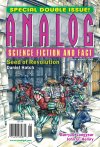 “Turning the Grain” Part I of II by Barry B. Longyear
“Turning the Grain” Part I of II by Barry B. Longyear
“Seed of Revolution” by Daniel Hatch
“Failure to Obey” by John G. Hemry
“The Bear Who Sang Opera” by Scott William Carter
“Payback” by Tom Ligon
“Duck and Cover” by Don D’Ammassa
“The Calculus Plague” by Marissa K. Lingen
“Global Warming” by Harry Turtledove
Reviewed by Karen L. Newman
In this double issue of Analog, human interaction is spotlighted. Although these stories are dark, the reader isn’t left depressed, but thoughtful. In each of the reviewed tales, except for the series “Turning the Grain” by Barry B. Longyear, characters are faced with tough choices that belie a human nature that hasn’t changed on the future Earth or on other planets. The past is referenced in each story and set in the past in two cases, with older histories mentioned. This thread runs constant, showing that humanity is a constant in the spectrum of time and imagination.
Mankind evolves beyond war in “Seed of Revolution” by Daniel Hatch. Only that aftermath isn’t explored. Here man is an angel on a planet where animals have evolved into free-thinking individuals. Hatch weaves a murder mystery entwined with strong characterization and plotting. The interbreeding concept is hard to believe, although presented well. The language is not typical of what one normally reads, but here adds to the overall foreign setting of the three-moon planet. Although this theme is well-worn, Hatch presents it in such a unique manner as to be memorable.
Making decisions is tough anyway, but add the stress of a terror attack in space, and you have the story “Failure to Obey” by John G. Hemry. The terror attack opens the tale, all from the viewpoint of a female Navy lieutenant. The action is gripping, although the writing has a few rough patches. The reader is sucked into the fray due to the fast-paced plotline. Unfortunately, the reader is sucked right back out with a lengthy trial that lasts over half the story. The closest analogy seems to be an extended episode of JAG on steroids, without any romance or strong character development. The technical jargon is repeated so much, it becomes tiring. The theme of free-thinking is clearly stated, which can be good sometimes, but tends to insult the reader, as it seems to do here. The ending of the trial is expected and delivered. If the trial had been cut down, this story might have lived up to its initial interest.
The old gumshoe detective story goes into the future with “The Bear Who Sang Opera” by Scott William Carter. Instead of a beautiful dame, the client is a biological-robot hybrid in the form of a bear who hires a PI to find his lost voice. Like the old tales, the characters are well-developed and interesting, each a possible suspect. However, in this futuristic tale the settings are stunning planets in various solar systems, not some filthy back alley or office. As in both, the fight scenes are realistic. Carter weaves a successful tribute to old-school detective stories with the modern twist of exposing man’s foibles.
Man’s fears come to life in “Payback” by Tom Ligon. An alien race launches a sun-destroying weapon. Back on Earth, debates rage on whether to retaliate. Ligon does a masterful job in tying ancient and current histories together and making them relevant to the future setting of this tale. The debates are realistic and eye-opening. Ligon’s grasp of the science is quite good, in part due to the help he received and acknowledged at the end of the story. This is science fiction at its best: well-developed characters delivering a universal message.
“Duck and Cover” by Don D’Ammassa is a cerebral tale about the inobservances of man. An unexplained phenomenon is discovered by an American soldier in Vietnam. Vivid characterization places the reader deep within the army camp. These characters are relatable even to a younger audience unfamiliar with the war. Careful plotting leads to a surprising discovery with no resolution that doesn’t diminish from the story’s overall effectiveness, but enhances it. Faulty research at the end – a character stated as senior senator from West Virginia (Robert C. Byrd was senior then even at that timeline) – will not be noticed by most, yet doesn’t take from the otherwise strong writing.
The premise of “The Calculus Plague” by Marissa K. Lingen is very original – catching memories by virus. Tension is masterfully built with each memory transmitted more horrific than the last. However, the story is rushed in places, the scenes changing too quickly. The science of how the transfer is made is unmentioned and causes doubt as to the story’s plausibility. Lingen’s characters do not appear to react to this nightmare in a realistic manner; some appear wooden. Because of this, the ending falls flat.
“Global Warming” is a thought-provoking vignette of the concern over global warming, except that Harry Turtledove doesn’t set the story today, or in the near future, but at the end of the ice age. His style of writing is off-setting at first, but soon pulls the reader in and never lets go. This “Probability Zero” segment spotlights the opposing viewpoint of today’s debate, with a startling result. Obviously, Turtledove is a master storyteller.